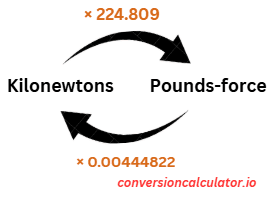HomeForce Converter
Force Conversion Calculator
Measure every push and pull, from newtons to pound-force.Force Converter
Convert from
Convert to
**Formula:
Discover Other Unit Converters
Try Other Force Converters
Dyne to Pound-forceDyne to NewtonKilogram-force to DyneKilogram-force to KilonewtonKilogram-force to Pound-forceKilogram-force to NewtonKilonewton to Kilogram-forceKilonewton to Pound-forceKilonewton to MeganewtonKilonewton to NewtonPound-force to DynePound-force to Kilogram-forcePound-force to KilonewtonPound-force to NewtonMeganewton to Kilogram-forceMeganewton to Kilonewton
Updated on September 1, 2025
Our force conversion calculator is a user-friendly tool that helps you quickly and accurately convert between eight different force units, including newtons, pound-force, kilogram-force, and more. It comes with various useful features like real-time results, adjustable settings, and a convenient history tracker that make your experience smoother and faster. In this article, I’ll explain the basics of force, how conversions work, and how our converter helps you save time and effort.About Our Force Conversion Calculator
Written By Nadiba Rahman
Nadiba Rahman
Reviewed by Mrinmoy Roy
Mrinmoy Roy
Share This Post
URL copied!
What is Force?
Force is a physical quantity that causes an object to change its motion. It can speed up, slow down, stop, or deform an object. According to Newton’s Second Law of Motion, force depends on two terms: mass and acceleration. The relationship is expressed as:F=m×a
where F is the force, m is the mass of an object, and a is the acceleration.
The standard unit for calculating force is the newton (N). One newton is the amount of force required to accelerate a 1-kilogram object by 1 meter per second squared.
Units of Our Force Conversion Calculator
Our calculator supports 8 force units for precise conversions:- Newton (N): It’s the SI unit of force used worldwide
- Kilogram-force (kgf): The force exerted by a one-kilogram mass under standard gravity (1 kgf ≈ 9.80665 newtons).
- Pound-force (lbf): A force unit mainly used in the US. It is the force exerted by a 1-pound mass under standard gravity.
- Kilonewton (kN): A derived unit of force, equal to 1,000 newtons.
- Dyne (dyne): A CGS (centimeter-gram-second) unit of force. One dyne is the force required to accelerate a 1-gram mass by 1 cm/s². 1 dyne = 10⁻⁵ newtons.
- Kips: It is primarily used in engineering, equal to 1,000 pounds-force.
- Meganewton (MN): A larger force unit, equal to 1 million newtons.
- Sthene (sn): 1 sthene is equal to 1000 newtons.
How to Use Our Force Converter?
Our force conversion calculator is simple to use. Here’s a step-by-step example:Select Source and Target Units
Select the units you want to convert from and to. For example, you want to convert Newtons to Pounds-force.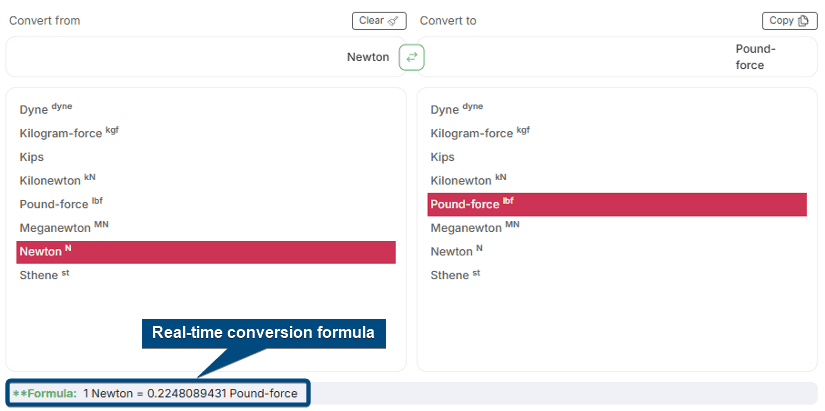
Enter the Force Value to Convert
Enter the force value you want to convert. For instance, let's convert 22 newtons to pounds-force.
View and Copy the Converted Results
Instantly see the converted value in the target unit. To copy the result, simply tap the one-click copy button.
Features of Our Force Conversion Calculator
Our force conversion calculator includes several features to simplify complex length unit conversions to your needs. All features are easy to access from the settings menu, and the image below shows the default settings for each feature.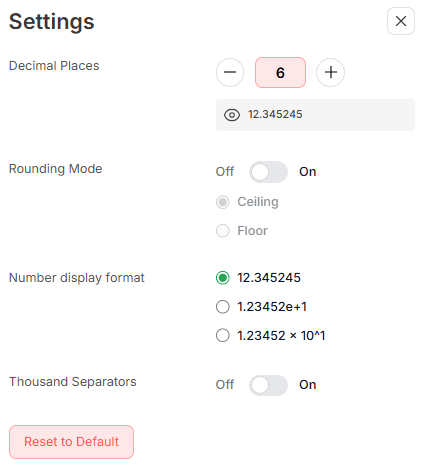
Real-Time Multi-Unit Conversion
Sometimes you need to see conversion results in multiple force units at once. Manually converting between them can be time-consuming and a hassle. That’s why our calculator includes a real-time multi-unit conversion feature. It automatically shows the equivalent values in all other force units as soon as you enter a number.Have a look at the following image:
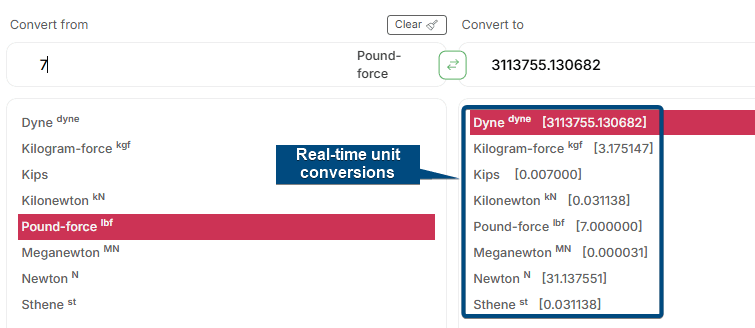
Flexible Decimal Precision
In force calculations, precision is crucial, especially when you’re doing physics experiments, designing machinery, or testing materials. Even a tiny difference in decimals can affect stress analysis, safety margins, or equipment settings.Our calculator lets you choose how many decimal places to display, anywhere from 0 to 12. The default is 6, but you can increase it if you need more exact results. The default value is 6, but you can increase it if you need more exact results.
For example, if you set it to 11 decimal places, converting 14 pounds-force (lbf) to newtons (N) will show 62.27510261365 N instead of just 62.28 N.
Rounding Mode Control
In force calculations, even small rounding differences can affect load distribution, equipment calibration, or structural design accuracy. That’s why our calculator includes rounding mode control.You can choose to round up, round down, or turn off rounding completely. This ensures your converted force values meet your project’s exact requirements, reducing the risk of calculation errors.
For example, if you set it to 11 decimal places, converting 14 pounds-force (lbf) to newtons (N) will show 62.27510261365 N instead of just 62.28 N.
Flexible Number Format
Force values can range from tiny dynes to massive meganewtons. Without a clear format, these numbers can be hard to read, share, or apply in your work.Our calculator offers three number display formats to match your needs:
- Standard Decimal (e.g., 98.0665)
- Scientific Notation (e.g., 9.80665e+1)
- Engineering Format (e.g., 9.80665 × 10^1)
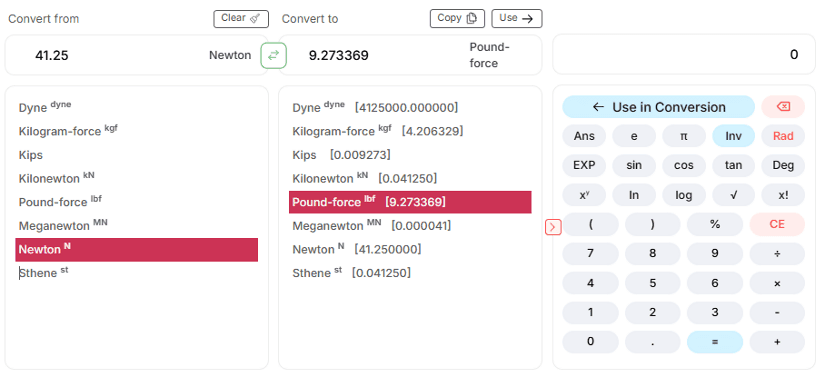
Thousand Separators Toggle
Large force values can be hard to read, and a missing digit can lead to mistakes in load calculations or data entry. Our calculator’s thousand-separator toggle adds commas to make long numbers easier to scan. For example, 8160053 dynes becomes 8,160,053 dynes, reducing the chance of errors and improving clarity when working with large datasets.One-click Unit Swap
Sometimes you need to check conversions in both directions, like converting newtons to pounds-force, then pounds-force back to newtons. Doing this manually can take extra time and increase the chance of mistakes.Our one-click unit swap feature solves this problem. With a single click, it instantly switches the input and output units, making it easy to double-check your work or compare both conversions quickly.
Auto-Saved Conversion History
When you’re doing multiple force conversions, it’s easy to lose track of your previous values. Manually re-entering them wastes time and can introduce errors.Our calculator automatically saves your last 10 conversions, even if you refresh or close your browser. Just open the History tab and click on any past entry to load it instantly. This makes your workflow faster, more organized, and error-free.

Force Conversion Chart
Download the following Force Conversion Chart to find all the conversion factors and compare different force units in one place.2 Examples of Conversion With Our Force Converter
To convert force units accurately, you need to know the source unit, the target unit, and the correct conversion factor (which you can find in the Force Conversion Chart above). The formula is simple:Converted Value = Source Value × Conversion Factor
Here are two quick examples to show how it works:
Converting Newtons (N) to Dynes (dyne)
To convert newtons to dynes, multiply the value in newtons by the conversion factor 100000. For example, to convert 1.5 newtons to dynes:1.5 × 100,000 = 150000 dynes
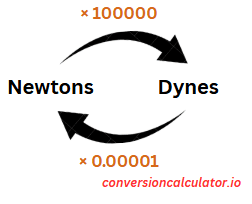
Converting Kilonewtons (kN) to Pounds-Force (lbf)
To convert kilonewtons to pounds-force, multiply the value of kilonewtons by the conversion factor 224.809. For example, to convert 5 kN to pounds-force:5 × 224.809 = 1124.045 lbf
